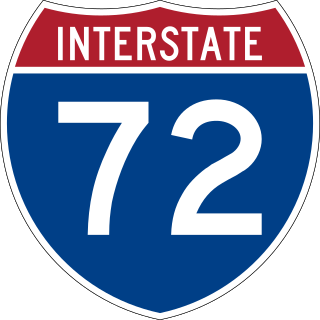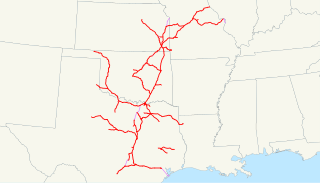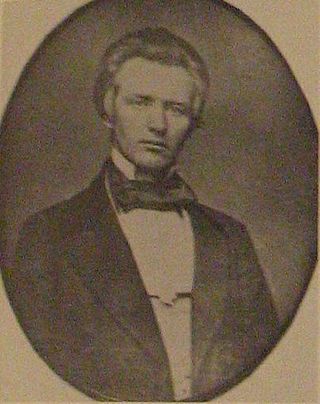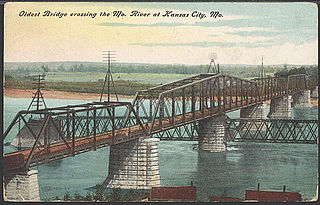
Interstate 72 (I-72) is an Interstate Highway in the midwestern United States. Its western terminus is in Hannibal, Missouri, at an intersection with U.S. Route 61 (US 61); its eastern terminus is at Country Fair Drive in Champaign, Illinois. The route runs through the major cities of Decatur, Illinois, and Springfield, Illinois. In 2006, the Illinois General Assembly dedicated all of I-72 as Purple Heart Memorial Highway. The stretch between Springfield and Decatur is also called Penny Severns Memorial Expressway, and the section between mile 35 and the Mississippi River is known as the Free Frank McWorter Historic Highway.

Kearney is a city in Clay County, Missouri, United States. The population per the 2020 U.S. Census was 10,404. The city was the birthplace of Jesse James, and there is an annual festival in the third weekend of September to recognize the outlaw. It is part of the Kansas City metropolitan area.

Cameron is a city in Clinton, DeKalb and Caldwell counties in the U.S. state of Missouri. The population was 8,513 at the 2020 census.

Hannibal is a city along the Mississippi River in Marion and Ralls counties in the U.S. state of Missouri. According to the 2020 U.S. Census, the population was 17,312, making it the largest city in Marion County. The bulk of the city is in Marion County, with a tiny sliver in the south extending into Ralls County.

The Missouri–Kansas–Texas Railroad was a Class I railroad company in the United States, with its last headquarters in Dallas, Texas. Established in 1865 under the name Union Pacific Railroad (UP), Southern Branch, it came to serve an extensive rail network in Texas, Oklahoma, Kansas, and Missouri. In 1988, it merged with the Missouri Pacific Railroad; today, it is part of UP.

The Santa Fe Trail was a 19th-century route through central North America that connected Franklin, Missouri, with Santa Fe, New Mexico. Pioneered in 1821 by William Becknell, who departed from the Boonslick region along the Missouri River, the trail served as a vital commercial highway until 1880, when the railroad arrived in Santa Fe. Santa Fe was near the end of El Camino Real de Tierra Adentro which carried trade from Mexico City. The trail was later incorporated into parts of the National Old Trails Road and U.S. Route 66.

The Chisholm Trail was a trail used in the post-Civil War era to drive cattle overland from ranches in Texas to Kansas railheads. The trail was established by Black Beaver, a Lenape guide and rancher, and his friend Jesse Chisholm, a Cherokee merchant. They collected and drove numerous cattle along the trail to Kansas, where they could be shipped east to achieve higher prices. The southern terminus was Red River Station, a trading post near the Red River along the northern border of Texas. The northern terminus was a trading post near Kansas City, Kansas. Chisholm owned both of these posts. In the years of the cattle drives, cowboys drove large herds from ranches across Texas to the Red River Station and then north to Kansas City.

Robert Marcellus Stewart was the 14th Governor of Missouri from 1857 to 1861, during the critical years just prior to the American Civil War.

Forgottonia, also spelled Forgotonia, is the name given to a 16-county region in Western Illinois in the late 1960s and early 1970s. This geographic region forms the distinctive western bulge of Illinois that is roughly equivalent to "The Tract", the Illinois portion of the Military Tract of 1812, along and west of the Fourth Principal Meridian. Since this wedge-shaped region lies between the Illinois and Mississippi rivers, it has historically been isolated from the eastern portion of Central Illinois.

The Hannibal and St. Joseph Railroad was the first railroad to cross Missouri starting in Hannibal in the northeast and going to St. Joseph, Missouri, in the northwest. It is said to have carried the first letter to the Pony Express on April 3, 1860, from a train pulled behind the locomotive Missouri.

The First Hannibal Bridge was the first permanent rail crossing of the Missouri River and helped establish Kansas City, Missouri, as a major city and rail center. The increased train traffic resulting from its construction also contributed to the building of Union Depot, the predecessor to the Kansas City Union Station.

Kersey Coates was a businessman from Kansas City, in the U.S. state of Missouri, who developed Quality Hill, founded the Kansas City Board of Trade, and was among those who attracted the Hannibal & St. Joseph Railroad to the city.

The Kansas City and Cameron Railroad was the subsidiary of the Hannibal and St. Joseph Railroad which built the first bridge across the Missouri River at the Hannibal Bridge.
The first Burning of Platte City, Missouri occurred during the American Civil War on December 16, 1861, after Union troops attempted to capture the bushwhacker Silas M. Gordon.
George Shepherd Park was a Texas War of Independence hero and founder of Parkville, Missouri, Park University, and Manhattan, Kansas. He helped establish Kansas State University.

U.S. Route 36 in the state of Missouri is an expressway with many freeway sections, connecting Kansas to Illinois. From Cameron to the Illinois state line, it forms part of the principal route between Kansas City and Chicago, known as the Chicago–Kansas City Expressway.

St. Munchin Parish is a parish of the Catholic Church located in Cameron, Missouri, in the Diocese of Kansas City–Saint Joseph. It is the mother church for St. Aloysius, a mission church in Maysville.

The North Missouri Railroad was a railway company that operated in the states of Missouri and Iowa in the mid-19th century. Incorporated in 1851, at its peak it owned or leased nearly 500 miles (800 km) of track. It was reorganized as the St. Louis, Kansas City and Northern Railway, a forerunner of the Wabash Railroad, in 1872.